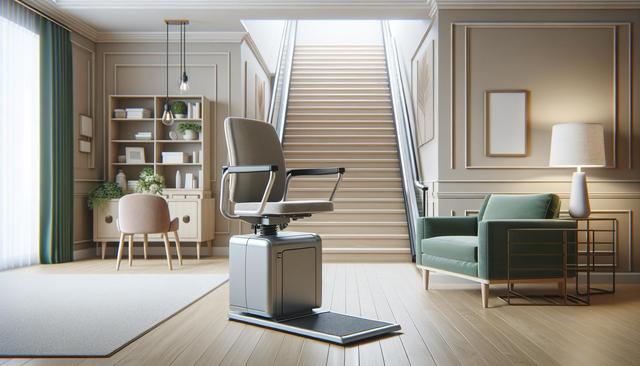Understanding Stair Lifts and Their Benefits for Seniors
A stair lift is a mechanical device designed to help individuals with mobility challenges move up and down stairs safely. For seniors who experience difficulty climbing stairs due to age-related conditions, installing a stair lift can significantly improve daily living and overall independence. These devices typically consist of a motorized chair or platform that glides along a rail mounted to the staircase. They are controlled by simple switches or remotes, making them accessible for users with limited dexterity.
Stair lifts come in various models, including straight, curved, and outdoor versions, to suit different home layouts and needs. The installation process is usually straightforward, especially for straight staircases, and modern designs are built with features such as swivel seats, safety belts, and obstruction sensors. These features contribute to a safer home environment, reducing the risk of falls, which are a leading cause of injury among older adults.
Some of the key benefits of stair lifts for seniors include:
- Enhanced home safety and fall prevention
- Increased independence and self-reliance
- Improved access to all areas of the home
- Peace of mind for family members and caregivers
Assessing the Cost of Stair Lifts
The cost of a stair lift can vary widely depending on several factors, including the type of staircase, the model chosen, and any additional safety or comfort features. On average, a basic straight stair lift may range from a few thousand dollars, while custom curved models can cost significantly more due to the complexity of installation. Installation fees and optional warranty coverage may also add to the overall expense.
It’s important for families to consider both the short-term and long-term value of investing in a stair lift. While the upfront cost may seem high, the potential savings from avoiding injury-related healthcare expenses and enabling aging in place can be substantial. Additionally, some manufacturers and dealers offer financing plans or rental options, which may help make the investment more manageable.
When evaluating the cost, it’s also wise to look for models with essential safety features and reliable maintenance support. Choosing a well-regarded provider can ensure that the equipment functions properly and remains in good condition for years to come.
Does Medicare Cover Stair Lifts for Seniors?
One of the most common questions surrounding stair lifts is whether Medicare will help cover the cost. Unfortunately, traditional Medicare typically does not cover stair lifts because they are considered home modifications rather than medically necessary equipment. While stair lifts can significantly enhance quality of life, they fall outside the scope of durable medical equipment (DME) that Medicare usually reimburses.
However, there are some exceptions and alternative routes to explore:
- Medicare Advantage Plans: Some private Medicare Advantage plans may offer supplemental benefits that include home modifications, such as stair lifts. Coverage varies by plan and location.
- Medicaid Waivers: In certain states, Medicaid Home and Community-Based Services (HCBS) waivers may help fund stair lifts for eligible individuals.
- Veterans Benefits: Veterans may qualify for assistance through programs offered by the Department of Veterans Affairs if the stair lift is deemed necessary due to a service-related condition.
- Local Assistance Programs: Nonprofit organizations or state-specific programs may offer financial aid or grants for home accessibility improvements.
It’s advisable to consult with a healthcare provider and insurance representative to explore all available options based on individual circumstances.
Evaluating Your Home and Needs Before Installation
Before purchasing a stair lift, it’s crucial to evaluate both the physical layout of the home and the specific mobility needs of the senior in question. Not all staircases are the same, and factors such as width, curves, landings, and outdoor exposure can influence the type of lift required. A professional assessment can help determine the most suitable model and ensure that the installation complies with safety standards.
In addition to the structural evaluation, it’s important to consider the user’s comfort and ease of use. For example, some seniors may benefit from a powered swivel seat or a higher weight capacity, depending on their physical condition. Others may prefer a foldable design to maximize space when the lift is not in use.
Here are a few steps to help guide the evaluation process:
- Measure the staircase dimensions, including width and length
- Identify any turns, landings, or obstructions
- Determine the user’s specific mobility challenges
- Consult with a certified installer for a comprehensive assessment
Taking the time to thoroughly assess your needs and options can lead to a more effective and satisfying solution.
Making an Informed Decision
Choosing the right stair lift involves balancing practicality, safety, and budget considerations. With many models and providers on the market, doing thorough research is essential. Seniors and their families should seek out well-regarded companies known for reliable products, transparent pricing, and responsive customer service. Reading user reviews and consulting with healthcare professionals can also provide valuable insights.
In addition to product research, understanding the long-term maintenance needs and warranty coverage is important. Stair lifts are mechanical devices that require periodic service to maintain peak performance. Opting for a model with accessible customer support and available replacement parts can minimize downtime and ensure continued usability.
Finally, remember that the decision to install a stair lift is not just about convenience—it’s about preserving independence and ensuring a safer living environment. By approaching the process with care and planning, seniors can find a stair lift solution that supports their lifestyle and enhances their quality of life.
Conclusion: Supporting Independence Through Practical Solutions
For seniors seeking to maintain independence while living in multi-level homes, stair lifts offer a practical and reliable mobility solution. Although traditional Medicare does not typically cover stair lifts, exploring alternatives like Medicare Advantage plans, Medicaid waivers, and local assistance programs can open up funding opportunities. By thoroughly evaluating the home layout, understanding the user’s mobility needs, and selecting a well-regarded provider, families can make informed decisions that enhance safety and comfort. Ultimately, investing in a stair lift is an investment in continued independence and peace of mind.


Leave a Reply